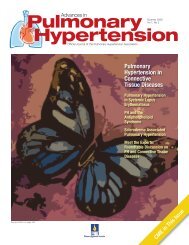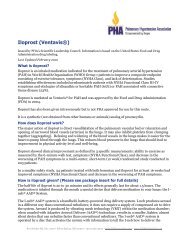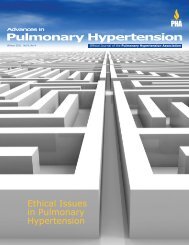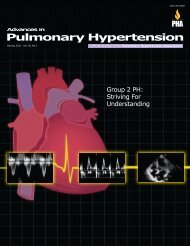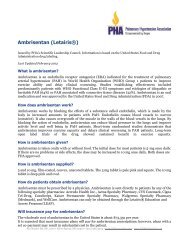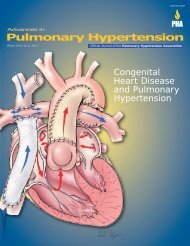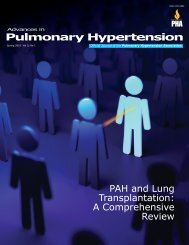Advances in Pulmonary Hypertension - PHA Online University
Advances in Pulmonary Hypertension - PHA Online University
Advances in Pulmonary Hypertension - PHA Online University
You also want an ePaper? Increase the reach of your titles
YUMPU automatically turns print PDFs into web optimized ePapers that Google loves.
Scleroderma-Associated <strong>Pulmonary</strong> <strong>Hypertension</strong>:<br />
Who’s at Risk and Why<br />
Karen A. Fagan, MD<br />
<strong>Pulmonary</strong> <strong>Hypertension</strong> Center<br />
<strong>University</strong> of Colorado<br />
Health Sciences Center<br />
Denver, Colorado<br />
David H. Collier, MD<br />
Division of Rheumatology<br />
Denver Health Medical Center<br />
Denver, Colorado<br />
Introduction<br />
<strong>Pulmonary</strong> arterial hypertension is a life-threaten<strong>in</strong>g complication<br />
of several connective tissue diseases, <strong>in</strong>clud<strong>in</strong>g both diffuse<br />
and limited scleroderma (with a subgroup of limited scleroderma<br />
called the CREST syndrome), systemic lupus erythematosus<br />
(SLE), mixed connective tissue disease (MCTD), and<br />
less commonly, rheumatoid arthritis, and dermatomyositis/<br />
polymyositis (Table 1). This review will discuss the <strong>in</strong>cidence,<br />
potential etiologies, cl<strong>in</strong>ical presentation, and treatment options<br />
for patients with pulmonary hypertension and the scleroderma<br />
spectrum of diseases.<br />
Epidemiology<br />
<strong>Pulmonary</strong> hypertension complicates several of the connective<br />
tissue diseases (Table 1). Scleroderma is a progressive, multisystem<br />
disease manifested by connective tissue and vascular<br />
lesions <strong>in</strong> many organs, <strong>in</strong>clud<strong>in</strong>g lung, kidney, and sk<strong>in</strong>.<br />
<strong>Pulmonary</strong> manifestations <strong>in</strong>clude <strong>in</strong>terstitial fibrosis, pulmonary<br />
arterial hypertension, constriction of the chest wall<br />
due to sk<strong>in</strong> thicken<strong>in</strong>g, diaphragmatic dysfunction, and chronic<br />
aspiration due to esophageal dysmotility. 1 <strong>Pulmonary</strong> complications<br />
are the most frequent cause of death <strong>in</strong> patients<br />
with scleroderma, 1 and pulmonary vascular disease has a<br />
particularly adverse effect on prognosis. 2<br />
The <strong>in</strong>cidence of pulmonary hypertension varies between<br />
6% and 60% of patients with scleroderma. Up to 33% of<br />
patients with diffuse scleroderma have pulmonary hypertension,<br />
both isolated and <strong>in</strong> association with <strong>in</strong>terstitial lung disease.<br />
3-6 In patients with limited scleroderma, formerly referred<br />
to as CREST (calc<strong>in</strong>osis cutis, Raynaud’s phenomenon,<br />
esophageal dysmotility, sclerodactyly, and telangiectasias), up<br />
to 60% of patients have pulmonary hypertension. 4, 6-8 While<br />
not all patients have cl<strong>in</strong>ically significant pulmonary hypertension,<br />
two thirds of patients with scleroderma will have pathologic<br />
evidence of pulmonary vascular disease. 7, 9 Stupi et al<br />
reported two-year survival <strong>in</strong> patients with CREST without pulmonary<br />
hypertension to be greater than 80% while patients<br />
with pulmonary hypertension had a two-year survival of 40%. 8<br />
Sacks et al reported two-year survival of patients with pulmonary<br />
hypertension and either diffuse or limited scleroderma<br />
to be approximately 50%. 5 Koh et al reported 40% survival <strong>in</strong><br />
David B. Badesch, MD<br />
<strong>Pulmonary</strong> <strong>Hypertension</strong> Center<br />
<strong>University</strong> of Colorado<br />
Health Sciences Center<br />
Denver, Colorado<br />
Table 1—Connective Tissue Diseases Associated<br />
with <strong>Pulmonary</strong> Arterial <strong>Hypertension</strong><br />
Scleroderma<br />
Diffuse<br />
Limited<br />
CREST<br />
Systemic lupus erythematosis<br />
Mixed connective tissue disease<br />
Rheumatoid arthritis<br />
Dermatomyositis/Polymyositis<br />
patients with scleroderma and pulmonary hypertension compared<br />
with higher survival <strong>in</strong> scleroderma patients without<br />
organ failure or with other lung <strong>in</strong>volvement (i.e. <strong>in</strong>terstitial<br />
lung disease) at two years. 2<br />
<strong>Pulmonary</strong> hypertension has been reported <strong>in</strong> 4% to 14%<br />
of patients with systemic SLE with an overall mortality rate of<br />
25% to 50% at two years from diagnosis of pulmonary hypertension.<br />
10-13 Patients with MCTD have features of several<br />
connective tissue diseases, <strong>in</strong>clud<strong>in</strong>g SLE, scleroderma,<br />
rheumatoid arthritis, and polymyositis. Most MCTD patients<br />
have either predom<strong>in</strong>antly SLE or scleroderma with a myositis<br />
overlap. The behavior of the disease therefore follows either<br />
a predom<strong>in</strong>antly SLE or a scleroderma pattern. The <strong>in</strong>cidence<br />
of pulmonary hypertension <strong>in</strong> patients with MCTD is not certa<strong>in</strong><br />
but one report found two thirds of patients with MCTD<br />
had evidence of pulmonary hypertension 14 and pulmonary<br />
hypertension has been frequently cited as a cause of death<br />
<strong>in</strong> patients with MCTD. 15 The high <strong>in</strong>cidence of pulmonary<br />
hypertension <strong>in</strong> MCTD is probably a result of the predom<strong>in</strong>ant<br />
scleroderma pattern of this disease <strong>in</strong> many patients with<br />
MCTD.<br />
Rheumatoid arthritis affects 5% of the population over<br />
age 65 and pulmonary complications <strong>in</strong>clude <strong>in</strong>terstitial pulmonary<br />
fibrosis, rheumatoid nodules, and pleural effusions.<br />
The <strong>in</strong>cidence of isolated pulmonary hypertension is not<br />
known. In a recent report, 21% of patients with rheumatoid<br />
arthritis without evidence of other pulmonary or cardiac dis-<br />
<strong>Advances</strong> <strong>in</strong> <strong>Pulmonary</strong> <strong>Hypertension</strong> 5



